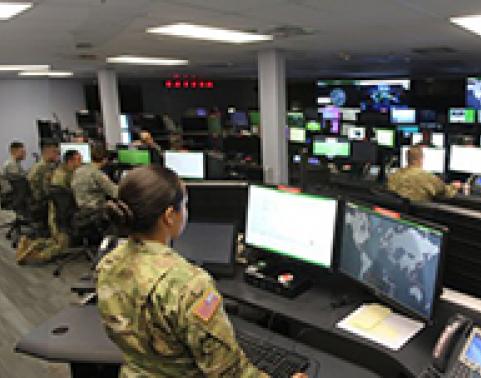MC4 Collaborates with Cyber Battle Lab for CSS VSAT Convergence

Medical Communications for Combat Casualty Care (MC4) engineers collaborated with the Fort Gordon Cyber Battle Lab in the Combat Service Support (CSS) Very Small Aperture Terminal (VSAT) Transport Convergence Focused Assessment from Nov. 28 through Dec. 15, 2017. In support of Cyber Command Battle Lab and Army Capability Integration Center, Defense Communications and Army Transmission Systems, Defense–Wide Transmission Systems, MC4 and Global Combat Support System – Army conducted a feasibility assessment to replace CSS-VSAT commercial teleport backbone facilities with Army Enterprise Gateways.
The focused assessment supports the Army’s future network transport convergence objectives. Soldiers and operators from the 3rd Infantry Division on Fort Stewart, Georgia, assisted with comparing user functionality between the existing CSS-VSAT network and one with proposed infrastructure changes. Additionally, these network changes leverage existing military infrastructure, maximize network resource and utilization, increase network security and simplify overall network management.
While visiting the site, Mr. Matthew Maier, product director, MC4, briefed the capability of the MC4 system. “If we don’t consider the network and bandwidth limitations of our operational forces up front, we will field systems that they can’t use,” said Mr. Maier. “Testing fielded Army capabilities on actual Army networks is critical to deployment. Getting a clear picture of the medical systems’ capabilities before they are shipped to theater is vital.”
Today’s CSS-VSAT network provides logistical and medical operational users connectivity through commercial gateways to their supporting business domains and data centers. The current global CSS satellite communications network relies on eight commercial satellites and eight geographically separated commercial gateways, all supported by an integrated network operations center. Proposed initial steps toward transport convergence may likely include collapsing the commercial gateways and terrestrial transport onto the Department of Defense Information Network, while continuing to use the existing CSS-VSAT terminals and integrated network operations center support.
The results of the Army Capability Integration Center-sponsored focused assessment will identify doctrine, organization, training, materiel, leadership, education, personnel, facilities and policy insights. The assessment will determine future capability requirements as well as shape a follow-on proof of concept at the Fort Detrick Army Enterprise Gateway scheduled for later in February 2018.
Related News
-
Inside BATDOK-J’s Soldier Touchpoint
April 28, 2025Soldiers at Fort Campbell’s 3rd Mobile Brigade Combat Team of the 101st Airborne Division (Air Assault) experimented with the Battlefield Assisted Trauma Distributed Observation Kit-Joint (BATDOK-J) application during a 21-day Soldier Touchpoint that started March 18. Soldiers assessed how BATDOK-J integrates with the Army’s Health Assessment Lite Operations (HALO) electronic health record under realistic, operational environments. -
8 questions with IPPS-A's Sabrina Simpson
March 4, 2025For Sabrina Simpson, every day is an opportunity to combine her love of numbers with her passion for supporting Soldiers. -
PEO Enterprise’s LACE helps programs implement consistent Agile metrics
February 26, 2025As U.S. Army Program Executive Office (PEO) Enterprise strives to enhance the speed and efficiency of its Agile software development practices, the acquisition organization’s Lean Agile Center of Excellence (LACE) is supporting the PEO’s portfolio of programs with a consistent set of metrics.
Work for Us
Join a winning team! Search for job opportunities with PEO Enterprise.
Work with Us
Help support important missions. Explore ways your company can work with PEO Enterprise.